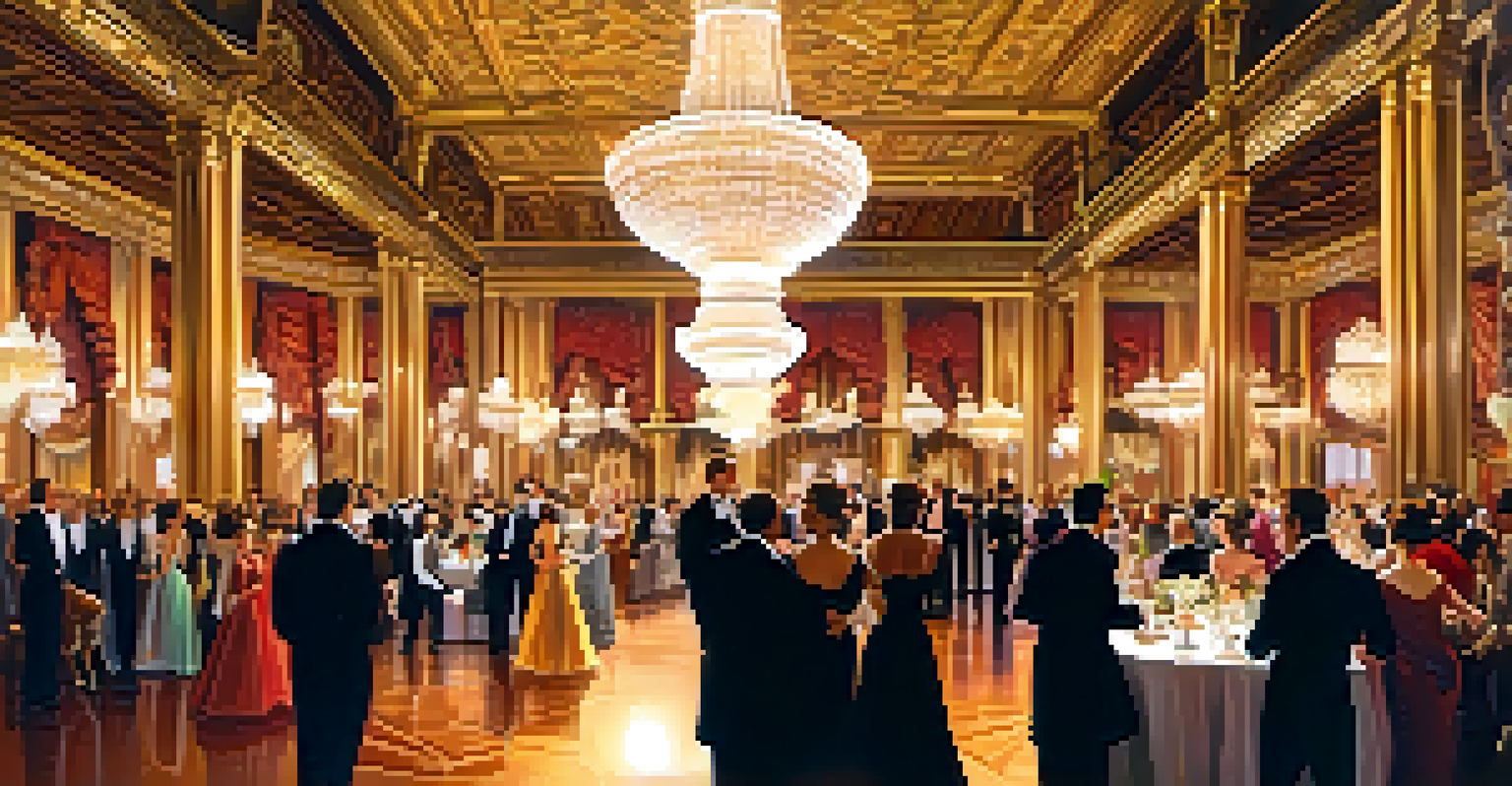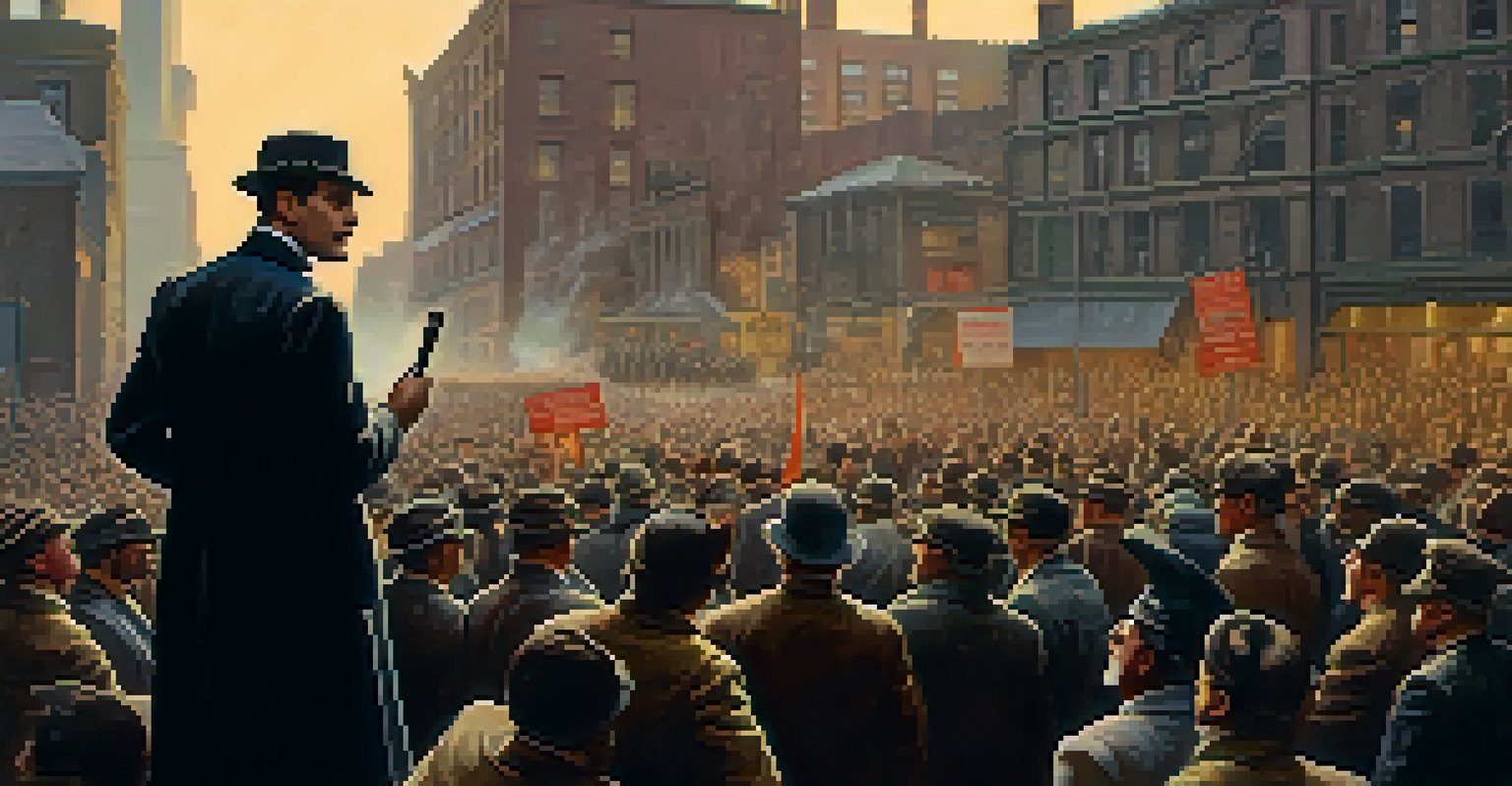The Gilded Age: Wealth, Corruption, and Change in NYC

Understanding the Gilded Age: A Brief Overview
The Gilded Age, spanning from the 1870s to about 1900, was a period of immense economic growth and stark social contrasts in the United States. Named by Mark Twain, this era showcased the glittering façades of wealth that often masked deep-seated issues like corruption and inequality. In New York City, this dynamic was particularly pronounced, as the city evolved into a booming hub of industry and finance.
The lack of money is the root of all evil.
During this time, the population surged, fueled by waves of immigrants seeking opportunities. Skyscrapers began to dot the skyline, symbolizing not just architectural ambition but also the burgeoning capitalist spirit. Yet beneath the surface, many faced harsh realities, including poor working conditions and poverty, which painted a more complicated picture of the American dream.
Ultimately, the Gilded Age laid the groundwork for significant social and political changes, as citizens began to question the status quo. The stark contrast between the opulence of the wealthy and the struggles of the working class sparked movements that would eventually reshape American society.
The Rise of Industrial Titans in NYC
At the heart of the Gilded Age was the rise of industrial magnates, often referred to as 'captains of industry' or, in some cases, 'robber barons.' Figures like John D. Rockefeller and Andrew Carnegie not only amassed incredible fortunes but also transformed the landscape of American business. In New York City, these titans established powerful corporations that dominated industries such as oil, steel, and railroads.

Their businesses thrived on innovation and expansion, yet their practices often raised ethical questions. Monopolistic strategies and cutthroat competition led to widespread corruption, as these industrialists sought to eliminate rivals by any means necessary. The influence of money in politics became starkly evident, with many politicians aligning themselves with these powerful figures to secure funding for their campaigns.
Economic Growth Amidst Inequality
The Gilded Age saw unprecedented economic expansion in the U.S., but this growth was accompanied by stark social contrasts and deep-rooted issues like poverty and corruption.
While some viewed these industrialists as visionary leaders who propelled the nation forward, others saw them as exploiters who prioritized profit over people. This duality sparked debates that would continue for decades, as society grappled with the implications of unchecked capitalism.
Wealth Disparity: The Rich and the Poor
The Gilded Age was characterized by a dramatic wealth disparity that was vividly illustrated in New York City. On one hand, opulent mansions lined Fifth Avenue, showcasing the extravagant lifestyles of the wealthy elite. On the other hand, just a few blocks away, tenements housed countless immigrant families living in cramped and unsanitary conditions, struggling to make ends meet.
With great wealth comes great responsibility.
This divide was not merely economic; it was also social and cultural. While the affluent hosted lavish parties and frequented high-end establishments, the working class often lacked access to basic necessities. The stark contrast was palpable, with the wealthy enjoying the fruits of industrialization while many laborers toiled long hours for meager wages.
As the divide grew, so did frustration among the working class, leading to a rise in labor movements. Workers began to organize and demand better pay, working conditions, and rights, setting the stage for significant social changes in the years to come.
Political Corruption: A Dark Underbelly
Political corruption thrived during the Gilded Age, particularly in urban centers like New York City. Politicians, often in league with business moguls, engaged in practices that undermined democratic principles. The infamous Tammany Hall, a political machine that wielded significant power, exemplified this corruption, using patronage and bribery to maintain control over the city's governance.
This entanglement of politics and business led to widespread cynicism among the populace. Many citizens felt their voices were drowned out by the interests of wealthy elites, leading to a sense of disenfranchisement. Investigative journalists of the era began to expose these corrupt practices, giving rise to the term 'muckraking,' which aimed to shed light on social injustices.
Rise of Industrial Moguls
Powerful industrialists like Rockefeller and Carnegie transformed American business, yet their monopolistic practices raised ethical concerns about the influence of wealth on politics.
The public's growing awareness of corruption fueled calls for reform, igniting movements that sought to clean up politics and make it more accountable to the people. This shift marked the beginning of a long battle against corruption that would continue well into the 20th century.
Cultural Flourishing Amidst Gilded Excess
Despite the glaring inequalities, the Gilded Age was also a time of cultural blossoming in New York City. The city became a cultural epicenter, with theaters, museums, and galleries springing up, reflecting the aspirations of a society grappling with its identity. The Metropolitan Museum of Art and Carnegie Hall became institutions that showcased the artistic achievements of the time.
Literature, music, and visual arts flourished as well, with figures like Mark Twain and Henry James capturing the complexities of American life. The era also saw the rise of new entertainment forms, such as vaudeville shows and mass-circulation newspapers, which entertained the masses and ignited public discourse. These cultural developments provided a counterpoint to the era's darker aspects, offering a glimpse of hope and creativity.
This vibrant cultural scene played an essential role in shaping the identity of New York City, as it became a melting pot of ideas and influences. As people from diverse backgrounds converged, they contributed to a rich tapestry of culture that would continue to evolve.
Social Movements: Voices for Change
The disparities and injustices of the Gilded Age ignited a series of social movements that aimed to address the pressing issues of the time. Labor unions began to form as workers organized to demand fair wages and better working conditions, pushing back against the exploitation they faced. Strikes and protests became common, as individuals sought a voice in an economy that often sidelined their needs.
In addition to labor movements, various social reform movements emerged, including those focused on women's rights, education, and social justice. Activists rallied for suffrage, advocating for women's right to vote, and sought to address issues such as child labor and public health. These movements laid the groundwork for future reforms that would reshape American society and governance.
Cultural Flourishing and Reform
Despite glaring inequalities, the Gilded Age fostered a rich cultural scene in New York City while igniting social movements that demanded change and accountability.
As citizens united for a common cause, they began to challenge the status quo, demanding accountability and justice. This collective action not only highlighted the struggles of the marginalized but also sparked a broader dialogue about the role of government in protecting its citizens.
Legacy of the Gilded Age: Lessons for Today
The Gilded Age left an indelible mark on American society, shaping the trajectory of the nation in profound ways. The lessons learned from this era of wealth and corruption continue to resonate today, as discussions around income inequality and corporate influence in politics remain relevant. The struggles of the working class laid the groundwork for labor laws and social safety nets that protect workers' rights.
Moreover, the cultural advancements of the Gilded Age remind us of the importance of creativity and expression in society. The arts and literature that flourished during this time continue to inspire new generations, highlighting the power of storytelling and shared experiences in fostering understanding and empathy.

As we reflect on the complexities of the Gilded Age, it becomes clear that history is not merely a series of events but a tapestry of human experience. By examining the past, we can better navigate the challenges of the present and work towards a more equitable future.